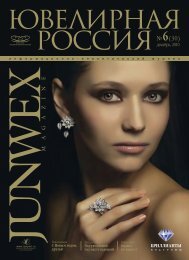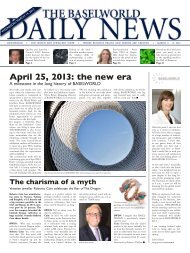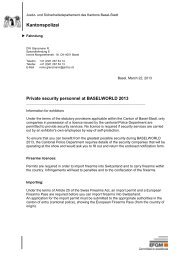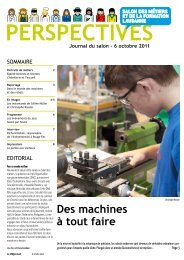WatchTime - August 2012
WatchTime - August 2012
WatchTime - August 2012
Create successful ePaper yourself
Turn your PDF publications into a flip-book with our unique Google optimized e-Paper software.
sales of luxury watches, especially in the United States, forced a<br />
change in ownership of the company. The brothers Charles and<br />
Jean Stern, owners of the Fabrique de Cadrans Stern Frères dial<br />
factory, who had a long and close business relationship with<br />
Patek Philippe, purchased the majority of the shares in the company<br />
in 1932. They hired as managing director Jean Pfister, director<br />
of the Geneva subsidiary of Tavannes Watch. The Sterns<br />
and Pfister decided that Patek Philippe should develop and produce<br />
its own in-house calibers. The decision, which would have<br />
far-reaching consequences, was initially limited to classic handwound<br />
movements in either tonneau or round cases. Patek<br />
Philippe’s top brass wasn’t quite ready to begin making their<br />
own base movement for chronographs. Nor was there a need to.<br />
Time-tested, precise and reliable hand-wound chronograph calibers<br />
were readily available from Valjoux SA, like the 13-ligne,<br />
5.85-mm-high column-wheel caliber 23VZ, which was<br />
launched in 1916.<br />
This movement underwent a thorough reworking and upgrading<br />
in accordance with the traditional philosophy of Patek<br />
Philippe, whose watchmakers used separate cocks to bear the<br />
escape wheel, the fourth wheel and the driving wheel. They also<br />
added a swan’s neck fine adjustment mechanism to the regulator’s<br />
pointer, gave an unusual shape to the chronograph bridge,<br />
and added the typical cover to the column wheel. They did the<br />
WHAT BEGAN IN 2009 WITH<br />
A MANUAL-WIND CHRONO BASE<br />
HAS CULMINATED IN THE<br />
496-COMPONENT CHR 29-535 PS Q.<br />
laborious work of completely redesigning the coupling yoke and<br />
giving it a bearing concentric with the staff of the fourth wheel,<br />
a solution already used in early Piguet calibers. This movement,<br />
which was hand-wound, combined a perpetual calendar with<br />
the split-seconds chronograph for the first time. It appeared in<br />
the legendary Reference 130, completed on Sept. 8, 1934. (The<br />
new owners also introduced Patek’s system of identifying watch<br />
models by reference number, beginning the series with the number<br />
“96.”) The 13-ligne movement, designated by number<br />
198.393, came in a 34-mm diameter case, the standard size for<br />
that era. This extraordinary timepiece was sold on Feb. 14,<br />
1938. Patek’s archives show that the split-seconds movement<br />
(without the escapement) cost approximately 600 Swiss francs.<br />
The painstakingly finished set of parts for the escapement cost<br />
124 francs. The perpetual calendar added 240 francs and the assembling<br />
another 250 francs. Patek Philippe manufactured a total<br />
of three watches of this type.<br />
Patek Philippe produced a number of split-second chronographs<br />
bearing reference number 1436. The exact number of<br />
split-second chronographs produced in the decades after the<br />
Sterns took over the company is not known. It is certain, how-<br />
SPECS<br />
PATEK PHILIPPE SPLIT-SECONDS CHRONO-<br />
GRAPH WITH PERPETUAL CALENDAR<br />
Manufacturer: Patek Philippe, Chemin<br />
du Pont-du-Centenaire 141, CH-1228,<br />
Plan-les-Ouates, Switzerland<br />
Reference number: 5204<br />
Functions: Hours, minutes, small seconds,<br />
column-wheel chronograph with elapsedseconds<br />
hand and jumping counter for<br />
up to 30 elapsed minutes; split-seconds<br />
function triggered by a button in the<br />
crown; perpetual calendar with day,<br />
month, leap-year cycle and day/night<br />
display in windows and date display in<br />
subdial at 6 o’clock, ultra-precise<br />
moon-phase display<br />
Movement: Hand-wound caliber CHR<br />
29-535 PS Q; diameter = 32 mm,<br />
height = 8.7 mm (including 1.65 mm for<br />
the perpetual calendar and 1.7 mm for<br />
the split-seconds mechanism); 496<br />
individual parts (including 182 for the<br />
perpetual calendar and 42 for the<br />
split-seconds mechanism with isolator),<br />
34 jewels, 65-hour power reserve,<br />
Gyromax balance with a frequency of<br />
28,800 vph, Breguet hairspring<br />
Case: 950 platinum, sapphire crystal;<br />
the solid platinum back can be removed<br />
and a threaded transparent back with a<br />
sapphire crystal inserted in its place;<br />
water resistant to 30 meters; Top<br />
Wesselton diamond between the lower<br />
pair of lugs; comes with corrector stylus<br />
made of ebony and 18k white gold<br />
Strap and clasp: Matte, black hand-sewn<br />
alligator strap; folding clasp made of 950<br />
platinum<br />
Dimensions: Diameter = 40 mm,<br />
height = 14.19 mm<br />
Price: $317,500<br />
ever, that the total quantity was fewer than 200 watches and<br />
thus significantly lower than the number of wristwatch chronographs<br />
with perpetual calendars produced during this same period.<br />
An impressive 281 examples of the perpetual calendar<br />
watch Reference 1518 were built between 1941 and 1954.<br />
PARTLY BECAUSE OF THE appearance on the market of the<br />
first automatic chronographs in 1969, Valjoux terminated production<br />
of its hand-wound chronograph caliber 23 VZ in 1974.<br />
The stock of ébauches nonetheless remained large enough to<br />
<strong>August</strong> <strong>2012</strong> <strong>WatchTime</strong> 57

















